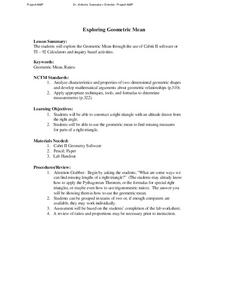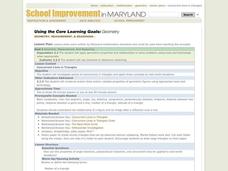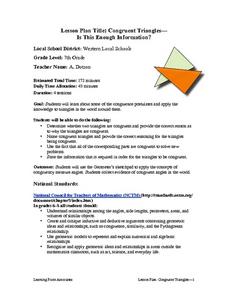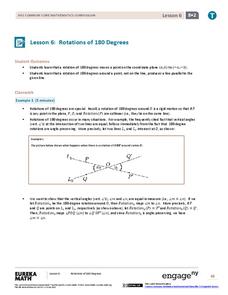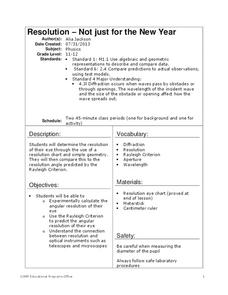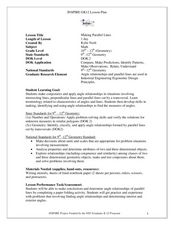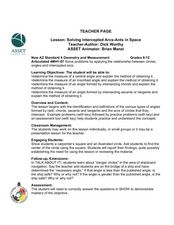Curated OER
Circumscribed Polygons
Students investigate polygons and construct ferris wheels. In this geometry lesson plan, students create a circle and differentiate properties of circles and polygons. They compare the relationship between angles and circumscribed polygons.
Curated OER
Side Splitter Triangles
Students investigate the side splitter theorem. For this geometry lesson, students estimate and solve problems dealing with ratios and proportions. They identify angles created by lines that are parallel.
Curated OER
Exploring the Properties of Rectangular Prisms.
Students define properties of rectangular prisms. In this geometry lesson, students identify the relationship between two and three dimensional objects. They use Cabri technology to graph their figures.
Curated OER
Exploring Properties of Rectangular Prisms
Learners explore the properties of rectangular prisms. In this geometry lesson, students identify properties of two and three dimensional shapes. They use Cabri technology to create polygons and solve problems.
Curated OER
Inscribed Quadrilaterals and Parallelograms
Students differentiate between inscribed quadrilaterals and parallelograms. For this geometry lesson, students identify the shaped of the polygons when it is inscribed inside of a circle. They calculate the missing angles of the...
Curated OER
Exploring Geometric Mean
Students solve problems using geometric means. In this geometry instructional activity, students create altitudes in right triangles. They use Cabri software to move the triangle around and observe different sides and angles.
Curated OER
Exploring Geometric Mean
Student identify the solution using geometric mean. In this geometry lesson, students create right triangles where the altitude of the triangle is the side containing the right angle. They modify shapes using Cabri software and observe...
Curated OER
Concurrent Lines in Triangles
Students explore the concept of concurrent lines in triangles. In this concurrent lines in triangles lesson, students work in groups to investigate properties of concurrent lines in acute, right, and obtuse triangles. Students use a...
Curated OER
Why can't We Use SSA to Prove Triangles Congruent?
Students investigate triangles and congruences. In this geometry lesson, students differentiate between inductive and deductive reasoning. They differentiate between similar and congruent triangles.
Curated OER
Triangles with Collinear Circumcenters
Students identify the circumcenter of a triangle. In this geometry lesson, students construct a perpendicular bisector using a straight edge and a compass. They differentiate between triangles and collinear points.
Curated OER
Composition of Reflections
Students perform reflections and translations of polygons. In this geometry lesson, students perform reflection in two parallel lines. They use Cabri to observe the transformation and rotations of each shape.
Curated OER
Inscribed Right Triangles
Students calculate the measurements of the inscribed angles of a triangle. In this geometry activity, students relate the hypotenuse of a right triangle and the diameter of a circle to each other. They calculate the diameter of a circle...
Curated OER
Dividing Line Segments into n Congruent Parts
Learners identify lines, and line segments. In this geometry lesson, students divide line segments into equal congruent parts. They complete a laboratory activity dealing with lines and segments.
Curated OER
Angles, Parallel Lines, and Polygons
Students examine how to investigate polygons using an instrument of their own construction. They should be able to prove the general formula for the number of degrees in any polygon (including a triangle). Finally they investigate an...
Curated OER
Congruent Triangles - Is This Enough Information?
Seventh graders examine congruence postulates and apply knowledge to triangles in the world around them.
EngageNY
Informal Proof of AA Criterion for Similarity
What does it take to show two triangles are similar? The 11th segment in a series of 16 introduces the AA Criterion for Similarity. A discussion provides an informal proof of the theorem. Exercises and problems require scholars to apply...
EngageNY
Rotations of 180 Degrees
What happens when rotating an image 180 degrees? The sixth lesson in the series of 18 takes a look at this question. Learners discover the pattern associated with 180-degree rotations. They then use transparency paper to perform the...
Cornell University
Resolution—Not Just for the New Year
Experiment with optical resolution using an inquiry-based lesson. Young researchers calculate fellow classmates' optical resolutions. They apply the information to understand the inner workings of optical instruments.
Curated OER
Making Parallel Lines
Students differentiate between parallel and perpendicular lines. In this geometry lesson, students make conjectures and apply it to solve real life situations. They collect data and make predictions based on the data.
Curated OER
Solving Intercepted Arcs
Pupils investigate circles and its arcs. In this geometry lesson, students identify the relationship between an circle and its intercepted arcs. THey identify the central and inscribed angles.
Curated OER
Obtuse Triangles
Fourth graders explore obtuse triangles. In this geometry instructional activity, 4th graders make obtuse triangles with paper and scissors. They determine how to find the center of their triangle.
Curated OER
Regular Polygons
Fifth graders explore polygons. In this math instructional activity, 5th graders find examples of regular polygons in the classroom and measure the sides of figures to determine if they are regular polygons.
Curated OER
Similar Triangles - Applied Problems
Students differentiate between similar and congruent triangles. In this geometry lesson, students identify the angles of triangles using the similarity theorem. They apply concepts of triangles to the real world.
Curated OER
Studying Special Segments in Triangles
Young scholars investigate special segments in triangles. In this geometry lesson, students graph, compare, estimate and predict findings based on their data. They differentiate between similarity and congruence of triangles.





